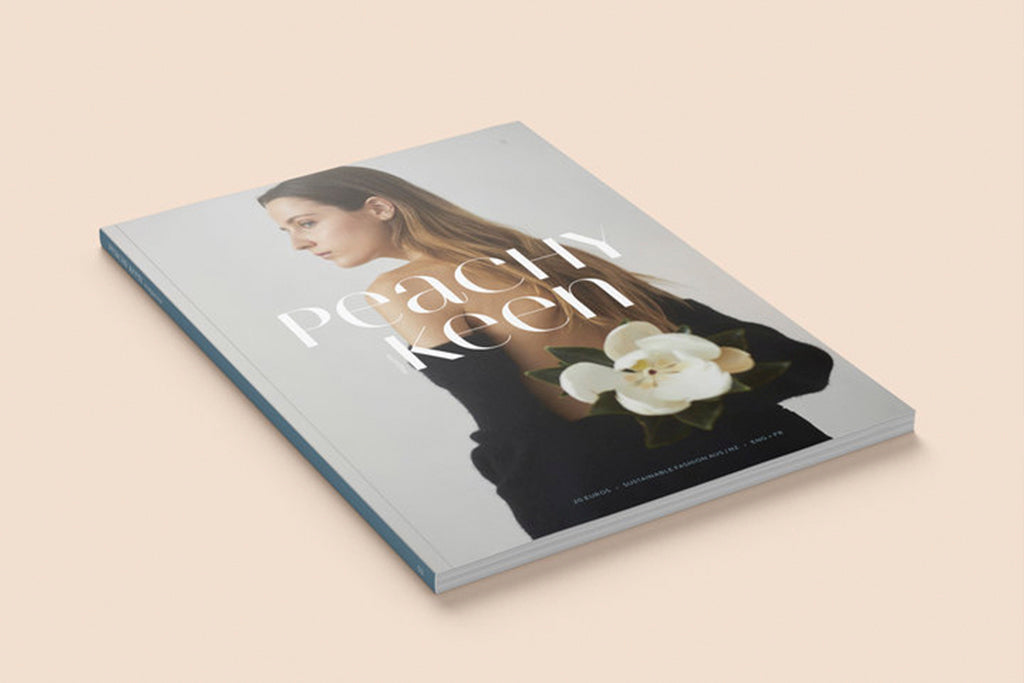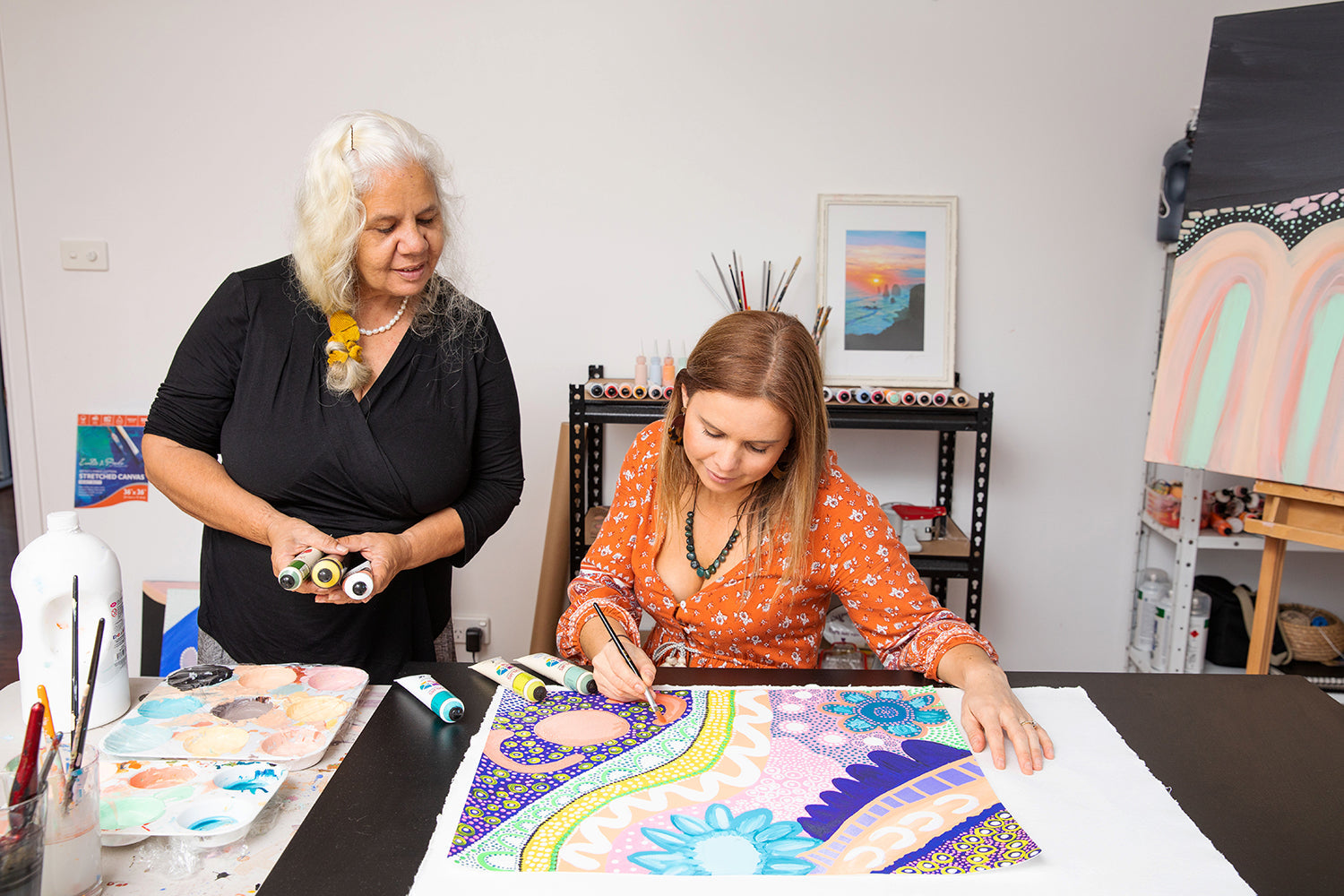Article: PEACHY KEEN - Featured Article by Sandy Greenwood

PEACHY KEEN - Featured Article by Sandy Greenwood
Miiimi & Jiinda is a new Australian Art business founded by Aboriginal mother and daughter, Melissa Greenwood and Lauren Jarrett. Launched on instagram in late 2018, Miimi & Jiinda’s traditional and contemporary Aboriginal artworks and hand woven baskets have won fans all over Australia. Known for its bright and distinctive style, Miimi & Jiinda creations tell visual stories about country and kin from the oldest surviving culture in the world.
Lauren Jarrett and Melissa are Indigenous Australian artists hailing from the Gumbaynggirr, Dunghutti and Bundjalung tribes of Australia’s East Coast. Often referred to as “Saltwater Country” their ancestral homelands are some of the most beautiful oceans, rivers, sub tropical rainforests, mountains and majestic waterfalls in the country, situated from the northern end of Byron Bay down to Kempsey in New South Wales. Lauren and Melissa are traditional owners of their ancestral homelands and proud custodians of the oldest surviving culture in the world which dates back to “time immemorial”, meaning time extending beyond the reach of memory. Lauren, 61, grew up on her ancestral “country” and was taught her culture and language from her mother, father and elders from a very young age.
This cultural knowledge has been handed down to her daughter Melissa, who has been painting and weaving since she was a young “Jarjum” (child). Lauren remembers fondly growing up as a child in the Australian bush “We would play all day, climbing trees and setting fishtraps. Our elders taught us about all the land, the waterways, the nature spirits and our relationship to the creatures. They spoke and sang in Gumbaynggirr language when it was safe to do so. I started weaving and drawing as a child and I would make things out of plants and would draw in the sand and dirt using sticks and stones. I was fascinated by bird’s nests and spider webs. From this childhood experience I learned that everything is connected and interdependent. As an Aboriginal child I understood that nature is the best teacher and I had the opportunity to work with water, fire, air and all natural materials. Then when I was 9 years old, the Australian government forcibly removed myself and my 13 siblings from our family and I spent the next 9 years in an orphanage. This is known as the Stolen Generations. Going into the orphanage we were constantly punished for doing or being anything Indigenous, so it was very confusing and confronting. By the time I was 17, I was a proper little white girl. When I did catch up with family I felt like a stranger and that I didn’t fit in. I knew that the healing I needed was cultural, I had to go and support my spirit and strengthen myself culturally. So I have. I was also determined to teach my children to feel strong and proud of their heritage."
Melissa now 35, grew up knowing and carrying the pain and trauma of what her mother endured but was also fortunate to grow up culturally strong. “Life was hard growing up, being raised by a single mum on welfare and carrying that intergenerational trauma in our DNA. But I’m so fortunate because although we were financially poor, we were culturally rich. Mum was determined for us to grow knowing who we were and have that connection that they tried to take from her. My memories of my childhood are growing up on Bundjalung and Gumbaynggirr country, collecting pippis on the beach with my mum and aunties, playing music around the fire with family and listening to stories told by my elders. Mum showed me the plants and fibres that our ancestors have weaved with for thousands of generations. I grew up playing in the same bush mum did although it was more developed by then. I would sit and play in our ancient birthing caves and I could always feel that ancestral presence around me. From a young age our house was filled with paint and brushes, weaving fibres and ochre. Mum taught me and my big sister our cultural dances and bit and pieces of our Gumbaynggirr language. I always wanted to be artist like mum.”
Their rich and ancient cultural heritage informs their artistic creations and they feel a strong sense of responsibility to keep culture alive. “When I paint I am evoking the spirit of mother earth, waking her up and infusing her with new energy, it is our cultural responsibility to keep dreaming stories alive and pass them down to our children. I also feel very passionate about reviving our weaving traditions because it is ancient womens business and it is inherently healing. I feel we can literally paint, draw and weave our pain away. I have a 3 year old son and I don’t want him to carry that ancestral pain. I want it to stop with me. As he grows up I want to empower him with the knowledge that he is a traditional owner of our lands and seas and a cultural custodian of our sacred cultural knowledge."
Lauren and Melissa formed Miimi & Jiinda in 2018 to create a platform to express their culture through art in determination to keep the stories alive. “We paint intuitively with ancestral guidance. Our work is all about keeping our culture alive and sharing our sacred stories. I want Australians to feel proud and connect to our shared cultural heritage, not to feel separate from it. Through colonisation, genocide and assimilation they literally attempted to wipe us completely out and destroy our culture. But we are survivors and this is a new dawn, we are the cultural custodians of our time. Through painting and weaving we can share the power and beauty of our cultural ways and share it for us all to benefit from, we can all experience the healing nature of these ancient stories” - Lauren
Text by Sandy Greenwood

